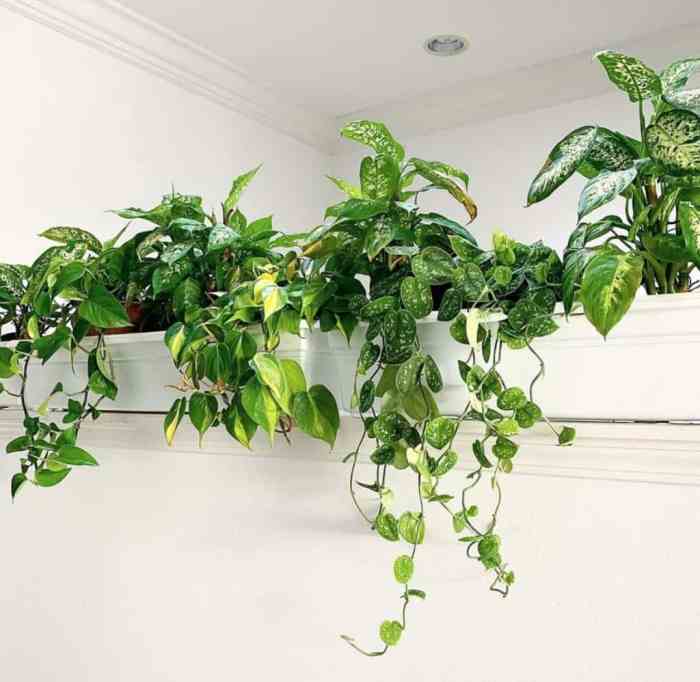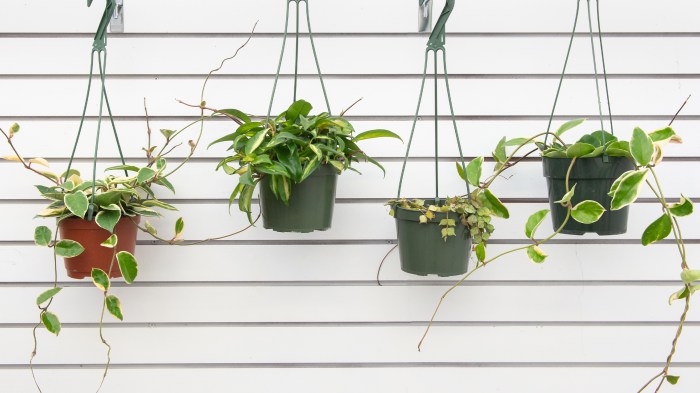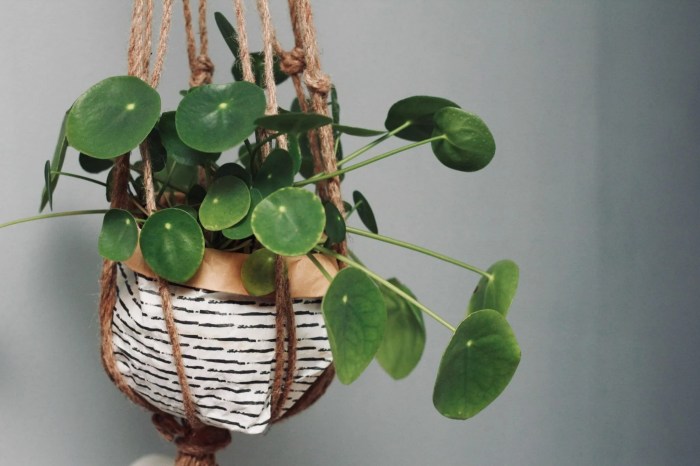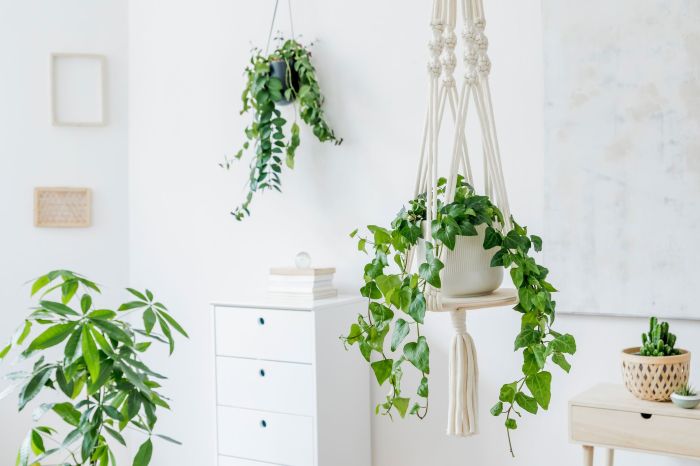In the realm of interior design, good hanging house plants reign supreme, transforming ordinary spaces into verdant havens. From cascading tendrils to lush foliage, these botanical wonders elevate any abode, adding a touch of nature’s beauty and a wealth of benefits.
Whether you’re a seasoned plant enthusiast or a budding green thumb, this comprehensive guide will provide you with the knowledge and inspiration to create stunning hanging displays that will bring joy and vitality to your indoor spaces.
Houseplants for Hanging Baskets

Hanging baskets provide a vertical element to your indoor greenery, adding depth and interest to your space. They’re also a great way to display trailing plants, which can cascade over the sides of the basket. When choosing plants for hanging baskets, there are a few things to keep in mind.
First, consider the size and shape of your basket. Smaller baskets will need plants that are relatively compact, while larger baskets can accommodate larger plants or multiple smaller plants. You’ll also want to consider the shape of your basket. Round baskets are ideal for plants that trail, while square or rectangular baskets are better suited for plants that grow upright.
Next, think about the amount of light your basket will receive. If your basket will be hanging in a bright spot, you can choose plants that need full sun or partial shade. If your basket will be hanging in a shadier spot, you’ll need to choose plants that are tolerant of low light.
Finally, consider your personal preferences. Do you prefer plants with colorful foliage, fragrant flowers, or unique textures? Once you’ve considered these factors, you can start choosing plants for your hanging basket.
Trailing Plants
Trailing plants are a popular choice for hanging baskets because they cascade over the sides of the basket, creating a lush, cascading effect. Some good trailing plants for hanging baskets include:
- Spider plant (Chlorophytum comosum): Spider plants are easy to care for and produce long, trailing stems with variegated leaves.
- Pothos (Epipremnum aureum): Pothos is another easy-care plant that produces long, trailing stems with heart-shaped leaves. It’s available in a variety of colors, including green, yellow, and white.
- Swedish ivy (Plectranthus verticillatus): Swedish ivy is a fast-growing plant that produces trailing stems with small, rounded leaves. It’s a good choice for baskets that are hanging in a shady spot.
Plant Care and Maintenance

Hanging houseplants add a touch of elegance and freshness to any home. To ensure their optimal growth and well-being, it is crucial to provide them with the proper care and maintenance. This includes meeting their specific lighting, watering, and humidity requirements, as well as regular fertilization, pruning, and repotting.
Lighting, Good hanging house plants
The lighting needs of hanging houseplants vary depending on the species. Some plants, such as ferns and philodendrons, thrive in low light conditions, while others, like succulents and cacti, prefer bright, indirect light. It is important to research the specific light requirements of your plants and adjust their placement accordingly.
Watering
Watering is another critical aspect of hanging plant care. Overwatering can lead to root rot, while underwatering can cause the plant to wilt and die. The best way to determine when to water your plants is to check the soil moisture.
Stick your finger into the soil up to the first knuckle. If the soil feels dry, it is time to water the plant. Allow the excess water to drain out of the pot to prevent waterlogging.
Hanging house plants bring life and freshness to any room, and the bedroom is no exception. For those seeking to add a touch of greenery to their sleeping quarters, good hanging plants for bedroom can provide numerous benefits. These plants not only enhance the aesthetics of the room but also contribute to improved air quality, promoting relaxation and restful sleep.
As part of a comprehensive guide to good hanging house plants, we delve into the specific advantages of hanging plants in the bedroom, offering recommendations and tips for selecting the most suitable varieties for this intimate space.
Humidity
Humidity is also an important factor to consider for hanging houseplants. Many plants, such as ferns and orchids, prefer high humidity. To increase the humidity around your plants, you can mist them regularly with water or use a humidifier. Alternatively, you can place your plants on a tray filled with pebbles and water.
The evaporating water will create a humid environment for your plants.
Creative Hanging Display Ideas

Transform your indoor space into a lush oasis by embracing innovative hanging display ideas for houseplants. Experiment with various plant combinations and unique containers to create visually captivating arrangements that add a touch of nature to your home.
Macrame Hangers
Craft intricate macrame hangers using natural fibers like cotton or jute. These bohemian-inspired designs add texture and warmth to your living space. Choose different knotting patterns and bead embellishments to personalize your creations.
Plant Shelves
Maximize vertical space with plant shelves. These multi-tiered structures allow you to display multiple plants at varying heights. Consider floating shelves for a modern touch or rustic wooden shelves for a cozy ambiance.
Ceiling Planters
Create a dramatic focal point by suspending ceiling planters from hooks or chains. This allows trailing plants to cascade down elegantly, adding a sense of movement and depth to your room.
Geometric Structures
Incorporate geometric shapes into your hanging displays. Wire frames, hexagonal planters, and diamond-shaped baskets provide a contemporary touch and add visual interest to your plant collection.
Good hanging house plants not only purify the air but also add a touch of greenery and vibrancy to any room. Flowering trailing plants, like the flowering trailing plants from HangingPlantsIndoor.com, are a particularly eye-catching choice. These plants feature long, cascading stems adorned with colorful blooms, creating a stunning visual display.
They are ideal for adding a pop of color and elegance to any hanging basket or planter, making them a great addition to any home décor.
Health Benefits of Hanging Houseplants

Incorporating hanging houseplants into indoor spaces offers a plethora of health advantages, ranging from improved air quality to enhanced mental well-being.
Scientific research has demonstrated the remarkable air-purifying abilities of hanging houseplants. These verdant companions effectively absorb and remove harmful pollutants, such as benzene, formaldehyde, and trichloroethylene, from the indoor environment. By doing so, they contribute to a cleaner, healthier atmosphere within our living spaces.
Psychological Benefits
Beyond their air-purifying capabilities, hanging houseplants also exert a profound impact on our psychological well-being. Studies have shown that the presence of plants in indoor spaces can significantly reduce stress levels and improve mood. Interacting with plants has been found to lower cortisol levels, a hormone associated with stress, and promote relaxation.
Furthermore, plants have been shown to enhance cognitive function and creativity. The vibrant colors and natural forms of plants stimulate the senses and provide a sense of tranquility, which can improve focus and concentration.
Health-Promoting Houseplants
Numerous hanging houseplants are renowned for their health-promoting qualities. Some notable examples include:
- Spider Plant (Chlorophytum comosum):Known for its ability to remove formaldehyde and xylene from the air.
- Peace Lily (Spathiphyllum wallisii):Effective in absorbing benzene, trichloroethylene, and ammonia.
- Snake Plant (Sansevieria trifasciata):Releases oxygen at night, improving air quality during sleep.
- Golden Pothos (Epipremnum aureum):Removes formaldehyde, xylene, and toluene from the air.
- Boston Fern (Nephrolepis exaltata):Effective in absorbing formaldehyde, xylene, and ammonia.
Advanced Hanging Plant Techniques: Good Hanging House Plants

Elevate your hanging plant game with advanced techniques that transform these verdant beauties into captivating works of art. From intricate training and shaping to innovative propagation methods, discover the secrets to creating unique and flourishing vertical gardens.
Training and Shaping
Harness the flexibility of hanging plants to train them into eye-catching forms. Employ trellises, hoops, or wire frames to guide their growth, creating spirals, cascades, or elegant arches. Regular pruning and pinching encourage bushy growth and desired shapes.
For those seeking aesthetically pleasing and purifying greenery indoors, hanging house plants offer a versatile solution. Among the most popular choices is the golden pothos indoor plant , renowned for its trailing vines and heart-shaped leaves variegated with golden hues.
Its air-purifying qualities make it a practical choice for improving indoor air quality, complementing other hanging house plants in creating a vibrant and healthy indoor environment.
Propagation through Cuttings or Division
Expand your hanging plant collection by propagating new plants from existing ones. Take stem cuttings or divide mature plants to create identical offspring. With careful attention to moisture, rooting hormone, and appropriate potting mix, you can effortlessly multiply your favorites.
Vertical Gardens with Hanging Plants and Trellises
Transform vertical spaces into lush green havens by combining hanging plants with trellises. Create living walls by suspending plants from trellises mounted on walls or fences. The combination of cascading foliage and structured support creates a captivating display that adds depth and greenery to any indoor or outdoor setting.
Final Conclusion

As we conclude our exploration of good hanging house plants, remember that incorporating these botanical companions into your home is not merely a decorative choice but an investment in well-being. Their air-purifying abilities, stress-reducing properties, and aesthetic appeal make them invaluable additions to any living space.
Embrace the beauty and benefits of hanging plants, and let them transform your indoor oasis into a thriving sanctuary.
FAQ Corner
What are the most popular hanging house plants?
Pothos, spider plants, philodendrons, and ferns are among the most popular hanging house plants due to their ease of care and attractive foliage.
How do I choose the right hanging basket size for my plant?
Select a hanging basket that is slightly larger than the root ball of your plant, allowing for some room for growth. Consider the weight of the plant and the strength of the basket.
How often should I water my hanging plants?
Water your hanging plants when the top inch of soil feels dry to the touch. Avoid overwatering, as this can lead to root rot.